IBM Power Systems S822LC as the foundation of enterprise IT
Power Systems is a line of servers based on IBM Power Architecture. In October 2015, Linux-models S812LC and S822LC with POWER8 processors came out in this line. In September of this year, they were modified and today are among the most preferred servers for medium-sized businesses, by the combination of form factor, scalability, versatility and price.

Over the past year, the interest of potential customers to S8xxLC has significantly increased, a large number of publications appeared in the press describing projects with these servers and the most preferred areas of use for them were well defined. The latest modifications of the S812LC and S822LC servers are listed as the newest in the general list of servers of the Power Systems line, which has more than 30 basic configurations.

Three new IBM Power Systems line of server models - S812LC, "S822LC for Big Data" and "S822LC for High Performance Computing"
')
All servers were originally designed to work under Linux. The junior model, the S812LC, is focused on workloads requiring large amounts of memory and data storage devices. It uses one POWER8 ten-core processor. Typical applications of the average model, “S822LC for Big Data”, are Hadoop and Spark tasks.
The most powerful model, the S822LC for HPC, is designed for commercial computing, such as online transaction processing. It typically uses 20 cores, 1 TB RAM, and a memory bandwidth of 230 GB / s. It also added two accelerators NVIDIA Tesla K80 GPU with massive parallel processing of data (massively parallel processing).
All servers are built on the basis of the IBM OpenPOWER Architecture, the direct heir to the PowerPC architecture, which has been refined over two decades of continuous research. The main goal of the development was to improve performance in a wide range of applications.
In 2013, the OpenPOWER Foundation community was established. Within its framework, IBM has opened many specifications for its members, from chipset design to firmware level (firmware) and basic utilities.
As a result, interested developers were able to deeply explore the capabilities of the system. Many of them (Mellanox, NVIDIA and others) then made important additions to the platform, expanding its capabilities and increasing productivity.
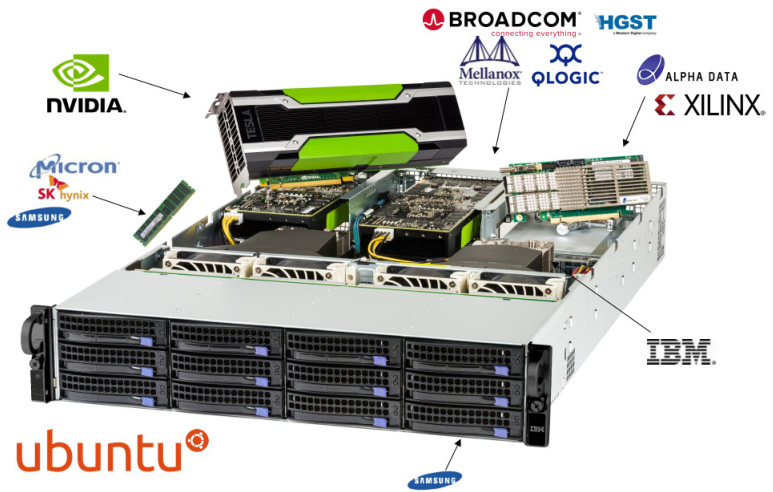
S8xxLC servers are the result of the collaboration of many leading developers and manufacturers of hardware and software.
In fact, IBM Power Systems has created a whole niche in the commercial UNIX industry. With this server portfolio, IBM hopes to take a leading position in real-time analytics and cloud computing — that is, in areas that are mainly related to Linux software stacks.
Linux has proven to be extremely suitable for areas where effective virtualization and building a secure network are key requirements. At the same time, the requirements of today's high-level computing tasks that are performed in real time often exceed the capabilities of mass-produced servers based on Intel technologies.
Datacenters are moving noticeably from batch processing to complex real-time analytics, respectively, requiring new computational models. This is largely true for open source projects such as Hadoop and Apache Spark. Of course, some optimization is possible within the software layer, but the performance ultimately depends on the hardware used.

Installing a 2U high S822LC server module in a 19-inch rack
This solution is well suited for customers who need large scalable computing power. It allows you to simultaneously increase the density of the workload and reduce the area requirements.
As part of a modular design can work from one to hundreds of servers. Model S822LC is easy to order and has a very promising roadmap in the use of graphics processors (GPU) to speed up the calculations.
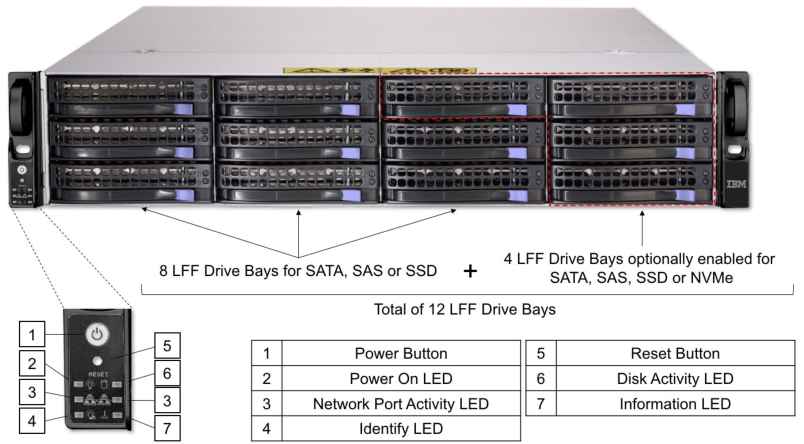
View of the front panel of the server and the indicator and control area (bottom left)
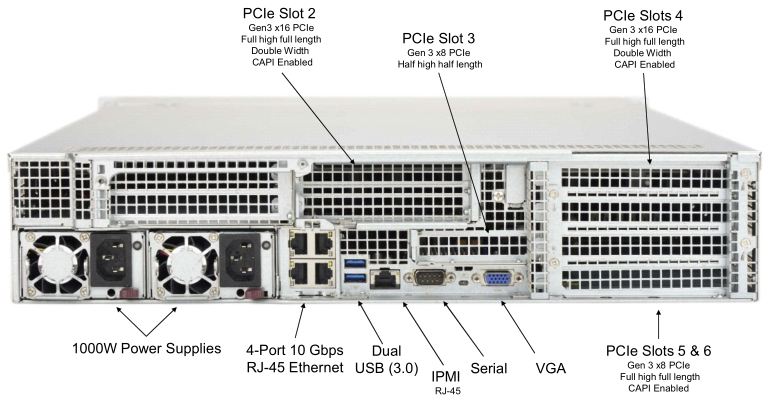
View of the back of the server with external connectors and power supplies

The location of the main elements of the server inside the case
- IBM POWER8 processors, standard operating at 2.92 or 3.32 GHz, with 8 or 10 fully activated cores
- Up to 1024 GB of RAM
- Five PCIe Gen3 slots, two of which only support GPUs
- Two hard drives with SATA interface for 1 TB, 7200 rpm, or two SSD SATA drives for 480 (or 960) GB
- Two Compute Intensive Accelerator GPU K80
- One front USB 2.0 port and one rear USB 3.0 port
- Two power supplies
- 19-inch rack-mount version 2U high
- Operating Systems:
Ubuntu Server 14.04.5 LTS
Ubuntu Server 16.04.1 LTS
Red Hat Enterprise Linux (RHEL) 7.2
In addition to the high “raw” server performance, data-optimized solutions (data-centric systems) and software-defined infrastructure (software-defined infrastructure) also use specially optimized applications.
In addition to the basic capabilities, open source tools for managing Extreme Cloud Administration Toolkit (xCAT) clusters can be used. Version xCAT 2.11.0 is available on Github. Firmware Open Power Abstraction Layer (OPAL) provides independent hypervisor and OS software layers, allowing you to automatically detect and correct errors.
Shortly after disclosing the details of the new-generation POWER9 processor, which will be available in 2017, IBM announced three new Linux servers with POWER8 and NVIDIA NVLink at the beginning of September of this year.
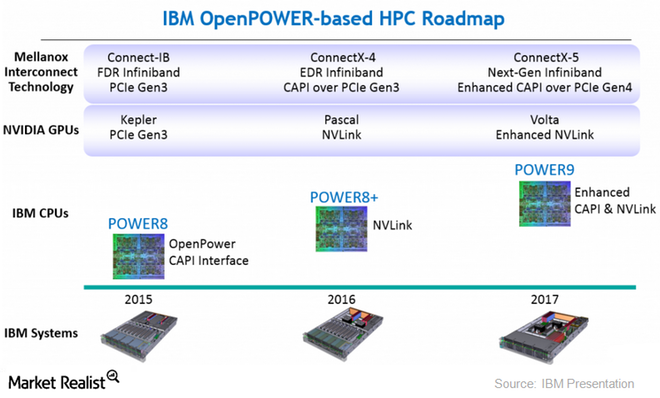
In configurations with the new POWER9 processor, new IBM POWER Systems servers will also receive new, more powerful NVLink tools.
The Power S822LC for High Performance Computing server (also known by the code name of its project, Minsky) uses a new processor (POWER8 with NVLink) to connect to the P100 Pascal GPU, the newest and most powerful GPU from NVIDIA.
Other servers — the Power S821LC base model and the Power S822LC for Big Data — can also connect to the NVIDIA K80 or P100 GPU, but through a PCIe interface. They are equipped with the IBM Coherent Accelerator Processor Interface (CAPI) for connecting to flash drives and FPGA (Field-Programmable Gate Array) .
Sumit Gupta, vice president of IBM High Performance Computing and Analytics, noted that the new servers are proof that IBM continues to work in the field of high-performance computing, as big data analytics and cognitive computing quickly occupy one of the central places in corporate IT .
According to IBM, the S822LC server with NVLink, made at the “silicon level”, allows data transfer five times faster than it does in comparable x86 systems. It also significantly reduces the complexity of software for using GPU in high-performance computing.
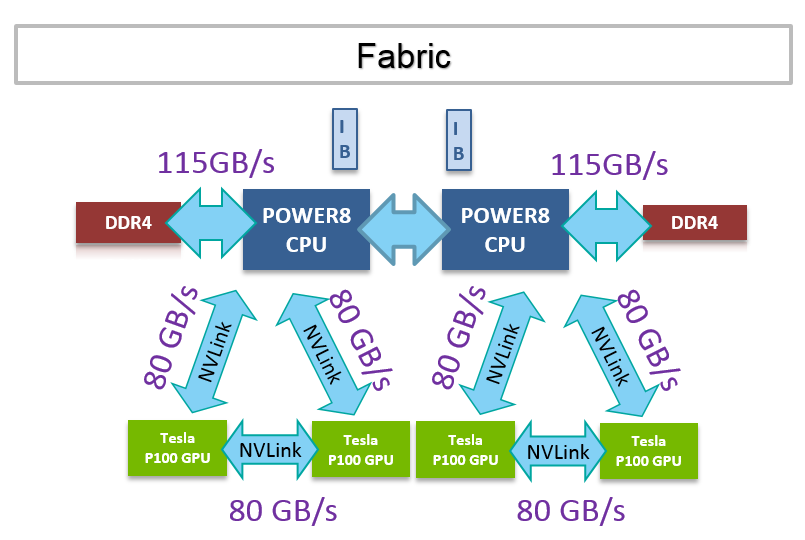 Using NVLink technology in a typical dual-processor configuration of the S822LC server.
Using NVLink technology in a typical dual-processor configuration of the S822LC server.
S822LC is the first system on POWER8 shipped with NVLink. Until now, the limitations of the previously used PCIe x16 Gen3 interface have been a bottleneck in the exchange of data between the central processor and the GPU. NVLink also makes programming much easier, since all data is now in the common space of system memory.
The new POWER8 with an integrated NVLink processor has 10 cores operating at up to 3.26 GHz. POWER8 processors in this server have a wider memory bandwidth than x86 processors (up to 115 GB / s) and can have up to half a terabyte of system memory per slot.
Since the POWER8 has a large internal cache, this, along with faster cores and a wide memory bandwidth, significantly increases the performance of user applications that require more processing power.
The new NVIDIA Tesla P100 graphics accelerator accelerates floating-point calculations, delivering performance up to 21 teraflops . It includes 16 GB of HBM2 stack memory and has a bandwidth of 720 GB / s.
Configurable into highly scalable Linux clusters, Power Systems offers high performance for large workloads, such as calculations involving human DNA (genomics), finance, computational chemistry, oil and gas research, data analytics, and many other areas.
In Big Data and analytics, cognitive systems are becoming increasingly important. Earlier hardware-software complexes were able to detect certain patterns in the data, analyzing the usual numerical relationships or sequences. But they could not isolate meaningful data encapsulated within a natural language — in text, video, or audio.
In order to detect them and to involve them in the analysis of the situation and the development of an informed decision, cognitive systems use natural language processing and machine learning. For example, the system may be configured to detect early signs of an epidemic of disease based on monitoring social networks, etc.
Cognitive systems analyze, among other things, unstructured data, which significantly reduces the level of insignificant "noise", clearing data from which often absorbs the majority of analyst time.
However, with a deeper level of analysis and the ability to "penetrate into the essence," cognitive systems, as a rule, are more expensive than conventional means. Intensive data processing requires a lot of computing power, and real-time analytics requires infrastructure optimized for maximum speed.
One of the first IBM customers to use Linux on the Power Systems architecture was Allegiant Air. She was engaged in analyzing consumer behavior in real time, and her goal was to directly generate individual offers for visitors to the shopping website, which increased sales.
This section lists some of the most frequently used IBM solutions and services for medium-sized enterprises based on the servers of the POWER Systems line. They provide businesses with new opportunities to revitalize their activities, while remaining within a limited IT budget.
Mobility . Worklight on Power solution implements a platform for mobile applications, which allows them to accelerate their development and ensure their management. This allows customers to relatively easily expand their business by adding mobile devices to their ecosystem.
The platform includes a complete development environment, middleware for optimizing runtime (mobile-optimized runtime middleware), a library of commercial enterprise applications, and an integrated management and analytics console.
Cloud IBM Power Systems Solution Edition for Scale-Out Cloud is an inexpensive, high-performance, high-bandwidth cloud platform. It combines the advantages of POWER8 technology with the flexibility of an open source hypervisor and extensive virtualization management capabilities.
Hadoop . The Power Systems platform is optimized to simplify and speed up big data analytics. It provides the infrastructure for fast processing of big data. This accelerates return on investment (ROI), including through simple deployment, use, management and support of big data management systems ...
The platform has better performance than other comparable solutions for Hadoop and provides better reliability and flexibility, with fewer failures and fewer runtime problems.
Other options and examples of using servers can be found here .
- Power Systems for Linux plus SAS Storage System DCS3700
- IBM Platform Cluster Manager control software and script installation tool
- Application software for Linux on Power - IBM InfoSphere BigInsights, IBM Platform Symphony Advanced Edition (accelerated MapReduce) and IBM GPFSTM
Servers of the Power Systems S8xxLC line are initially focused on the high-level market of hardware and software solutions for business. However, this does not mean that small sites and applications can not benefit from their use.
For example, cloud providers that move to new IBM servers will provide customers with faster data processing at lower prices. "Heavy" Web applications, in turn, will get more processing power and richer API functionality.
It can be said that the significant increase in computing power available in the new IBM servers opens up new opportunities for the Linux community as a whole - and we can expect even more innovation in real-time high-performance computing.
1. Implementing an IBM High-Performance Computing Solution on IBM Power System 822LC IBM Redbooks Publication
2. High performance computing (HPC) and technical computing solutions
3. IBM PowerSystems Home Page

Over the past year, the interest of potential customers to S8xxLC has significantly increased, a large number of publications appeared in the press describing projects with these servers and the most preferred areas of use for them were well defined. The latest modifications of the S812LC and S822LC servers are listed as the newest in the general list of servers of the Power Systems line, which has more than 30 basic configurations.
First look at the S812LC and S822LC

Three new IBM Power Systems line of server models - S812LC, "S822LC for Big Data" and "S822LC for High Performance Computing"
')
All servers were originally designed to work under Linux. The junior model, the S812LC, is focused on workloads requiring large amounts of memory and data storage devices. It uses one POWER8 ten-core processor. Typical applications of the average model, “S822LC for Big Data”, are Hadoop and Spark tasks.
The most powerful model, the S822LC for HPC, is designed for commercial computing, such as online transaction processing. It typically uses 20 cores, 1 TB RAM, and a memory bandwidth of 230 GB / s. It also added two accelerators NVIDIA Tesla K80 GPU with massive parallel processing of data (massively parallel processing).
All servers are built on the basis of the IBM OpenPOWER Architecture, the direct heir to the PowerPC architecture, which has been refined over two decades of continuous research. The main goal of the development was to improve performance in a wide range of applications.
In 2013, the OpenPOWER Foundation community was established. Within its framework, IBM has opened many specifications for its members, from chipset design to firmware level (firmware) and basic utilities.
As a result, interested developers were able to deeply explore the capabilities of the system. Many of them (Mellanox, NVIDIA and others) then made important additions to the platform, expanding its capabilities and increasing productivity.

S8xxLC servers are the result of the collaboration of many leading developers and manufacturers of hardware and software.
In fact, IBM Power Systems has created a whole niche in the commercial UNIX industry. With this server portfolio, IBM hopes to take a leading position in real-time analytics and cloud computing — that is, in areas that are mainly related to Linux software stacks.
Linux has proven to be extremely suitable for areas where effective virtualization and building a secure network are key requirements. At the same time, the requirements of today's high-level computing tasks that are performed in real time often exceed the capabilities of mass-produced servers based on Intel technologies.
Datacenters are moving noticeably from batch processing to complex real-time analytics, respectively, requiring new computational models. This is largely true for open source projects such as Hadoop and Apache Spark. Of course, some optimization is possible within the software layer, but the performance ultimately depends on the hardware used.
IBM POWER Systems S822LC server

Installing a 2U high S822LC server module in a 19-inch rack
This solution is well suited for customers who need large scalable computing power. It allows you to simultaneously increase the density of the workload and reduce the area requirements.
As part of a modular design can work from one to hundreds of servers. Model S822LC is easy to order and has a very promising roadmap in the use of graphics processors (GPU) to speed up the calculations.
Power System S822LC Design

View of the front panel of the server and the indicator and control area (bottom left)

View of the back of the server with external connectors and power supplies

The location of the main elements of the server inside the case
Power System S822LC Configuration
- IBM POWER8 processors, standard operating at 2.92 or 3.32 GHz, with 8 or 10 fully activated cores
- Up to 1024 GB of RAM
- Five PCIe Gen3 slots, two of which only support GPUs
- Two hard drives with SATA interface for 1 TB, 7200 rpm, or two SSD SATA drives for 480 (or 960) GB
- Two Compute Intensive Accelerator GPU K80
- One front USB 2.0 port and one rear USB 3.0 port
- Two power supplies
- 19-inch rack-mount version 2U high
- Operating Systems:
Ubuntu Server 14.04.5 LTS
Ubuntu Server 16.04.1 LTS
Red Hat Enterprise Linux (RHEL) 7.2
In addition to the high “raw” server performance, data-optimized solutions (data-centric systems) and software-defined infrastructure (software-defined infrastructure) also use specially optimized applications.
In addition to the basic capabilities, open source tools for managing Extreme Cloud Administration Toolkit (xCAT) clusters can be used. Version xCAT 2.11.0 is available on Github. Firmware Open Power Abstraction Layer (OPAL) provides independent hypervisor and OS software layers, allowing you to automatically detect and correct errors.
New servers on POWER8 with NVLink
Shortly after disclosing the details of the new-generation POWER9 processor, which will be available in 2017, IBM announced three new Linux servers with POWER8 and NVIDIA NVLink at the beginning of September of this year.

In configurations with the new POWER9 processor, new IBM POWER Systems servers will also receive new, more powerful NVLink tools.
The Power S822LC for High Performance Computing server (also known by the code name of its project, Minsky) uses a new processor (POWER8 with NVLink) to connect to the P100 Pascal GPU, the newest and most powerful GPU from NVIDIA.
Other servers — the Power S821LC base model and the Power S822LC for Big Data — can also connect to the NVIDIA K80 or P100 GPU, but through a PCIe interface. They are equipped with the IBM Coherent Accelerator Processor Interface (CAPI) for connecting to flash drives and FPGA (Field-Programmable Gate Array) .
Sumit Gupta, vice president of IBM High Performance Computing and Analytics, noted that the new servers are proof that IBM continues to work in the field of high-performance computing, as big data analytics and cognitive computing quickly occupy one of the central places in corporate IT .
According to IBM, the S822LC server with NVLink, made at the “silicon level”, allows data transfer five times faster than it does in comparable x86 systems. It also significantly reduces the complexity of software for using GPU in high-performance computing.
 Using NVLink technology in a typical dual-processor configuration of the S822LC server.
Using NVLink technology in a typical dual-processor configuration of the S822LC server.S822LC is the first system on POWER8 shipped with NVLink. Until now, the limitations of the previously used PCIe x16 Gen3 interface have been a bottleneck in the exchange of data between the central processor and the GPU. NVLink also makes programming much easier, since all data is now in the common space of system memory.
The new POWER8 with an integrated NVLink processor has 10 cores operating at up to 3.26 GHz. POWER8 processors in this server have a wider memory bandwidth than x86 processors (up to 115 GB / s) and can have up to half a terabyte of system memory per slot.
Since the POWER8 has a large internal cache, this, along with faster cores and a wide memory bandwidth, significantly increases the performance of user applications that require more processing power.
The new NVIDIA Tesla P100 graphics accelerator accelerates floating-point calculations, delivering performance up to 21 teraflops . It includes 16 GB of HBM2 stack memory and has a bandwidth of 720 GB / s.
Positioning S82x for Linux servers
Configurable into highly scalable Linux clusters, Power Systems offers high performance for large workloads, such as calculations involving human DNA (genomics), finance, computational chemistry, oil and gas research, data analytics, and many other areas.
In Big Data and analytics, cognitive systems are becoming increasingly important. Earlier hardware-software complexes were able to detect certain patterns in the data, analyzing the usual numerical relationships or sequences. But they could not isolate meaningful data encapsulated within a natural language — in text, video, or audio.
In order to detect them and to involve them in the analysis of the situation and the development of an informed decision, cognitive systems use natural language processing and machine learning. For example, the system may be configured to detect early signs of an epidemic of disease based on monitoring social networks, etc.
Cognitive systems analyze, among other things, unstructured data, which significantly reduces the level of insignificant "noise", clearing data from which often absorbs the majority of analyst time.
However, with a deeper level of analysis and the ability to "penetrate into the essence," cognitive systems, as a rule, are more expensive than conventional means. Intensive data processing requires a lot of computing power, and real-time analytics requires infrastructure optimized for maximum speed.
One of the first IBM customers to use Linux on the Power Systems architecture was Allegiant Air. She was engaged in analyzing consumer behavior in real time, and her goal was to directly generate individual offers for visitors to the shopping website, which increased sales.
This section lists some of the most frequently used IBM solutions and services for medium-sized enterprises based on the servers of the POWER Systems line. They provide businesses with new opportunities to revitalize their activities, while remaining within a limited IT budget.
Mobility . Worklight on Power solution implements a platform for mobile applications, which allows them to accelerate their development and ensure their management. This allows customers to relatively easily expand their business by adding mobile devices to their ecosystem.
The platform includes a complete development environment, middleware for optimizing runtime (mobile-optimized runtime middleware), a library of commercial enterprise applications, and an integrated management and analytics console.
Cloud IBM Power Systems Solution Edition for Scale-Out Cloud is an inexpensive, high-performance, high-bandwidth cloud platform. It combines the advantages of POWER8 technology with the flexibility of an open source hypervisor and extensive virtualization management capabilities.
Hadoop . The Power Systems platform is optimized to simplify and speed up big data analytics. It provides the infrastructure for fast processing of big data. This accelerates return on investment (ROI), including through simple deployment, use, management and support of big data management systems ...
The platform has better performance than other comparable solutions for Hadoop and provides better reliability and flexibility, with fewer failures and fewer runtime problems.
Other options and examples of using servers can be found here .
Typical composition of the solution
- Power Systems for Linux plus SAS Storage System DCS3700
- IBM Platform Cluster Manager control software and script installation tool
- Application software for Linux on Power - IBM InfoSphere BigInsights, IBM Platform Symphony Advanced Edition (accelerated MapReduce) and IBM GPFSTM
Conclusion
Servers of the Power Systems S8xxLC line are initially focused on the high-level market of hardware and software solutions for business. However, this does not mean that small sites and applications can not benefit from their use.
For example, cloud providers that move to new IBM servers will provide customers with faster data processing at lower prices. "Heavy" Web applications, in turn, will get more processing power and richer API functionality.
It can be said that the significant increase in computing power available in the new IBM servers opens up new opportunities for the Linux community as a whole - and we can expect even more innovation in real-time high-performance computing.
Additional Information
1. Implementing an IBM High-Performance Computing Solution on IBM Power System 822LC IBM Redbooks Publication
2. High performance computing (HPC) and technical computing solutions
3. IBM PowerSystems Home Page
Source: https://habr.com/ru/post/315184/
All Articles